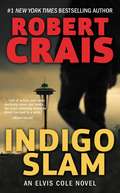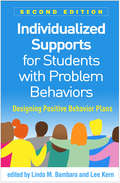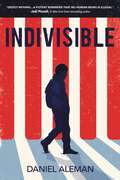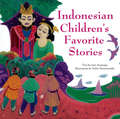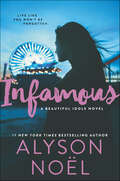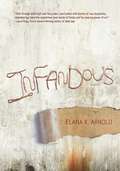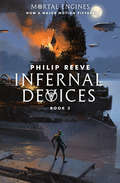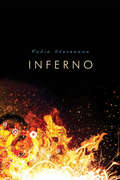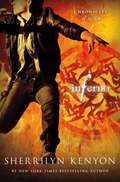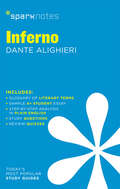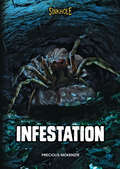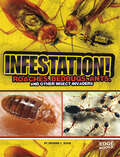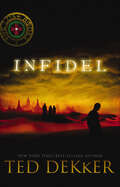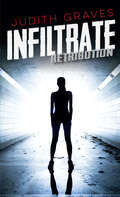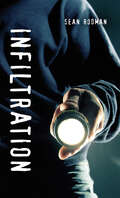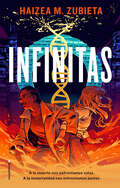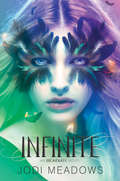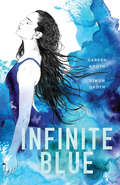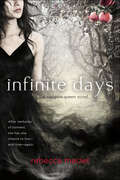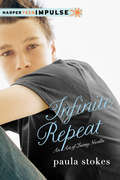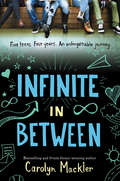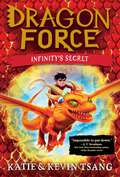- Table View
- List View
Indigo Slam: An Elvis Cole Novel (Elvis Cole #7)
by Robert CraisAvailable for the first time as an ebook!Life in the California sun suits Elvis Cole--until the day a fifteen-year-old girl and her two younger siblings walk into his office. Then everything changes.Three years ago, a Seattle family ran for their lives in a hail of bullets. Hired by three kids to find their missing father, Elvis now must pick up the cold pieces of a drama that began that night. What he finds is a sordid tale of high crimes and illicit drugs. As clues to a man's secret life emerge from the shadows, Elvis knows he's not just up against ruthless mobsters and some very angry Feds. He's facing a storm of desperation and conspiracy--bearing down on three children whose only crime was their survival...
Individualized Supports for Students with Problem Behaviors, Second Edition: Designing Positive Behavior Plans (The\guilford School Practitioner Ser.)
by Linda M. Bambara Lee KernNoted for providing everything needed to develop individualized positive behavior support (PBS) plans for students with pervasive behavioral challenges, this authoritative guide has been revised and expanded to reflect 15 years of changes in the field. The book walks practitioners through the PBS process, emphasizing a team-based approach and presenting assessment procedures, intervention strategies, and guiding questions. Detailed case examples illustrate ways to meet the diverse needs of students across abilities, grade levels (PreK–12), and problem behaviors. In a convenient large-size format, the book follows the sequence of a typical PBS course, making it ideal for use in teaching and training. New to This Edition *Incorporates current tools and practices within an expanded, whole-school PBS approach. *Chapters on multi-tiered systems of support and the fundamentals of classroom management. *Chapter on writing, monitoring, and evaluating a complete PBS plan. *Two extended case examples that run through many of the chapters. *&“Commentaries from the Field&” in which leading experts reflect on the contributions, challenges, and future directions of PBS.
Indivisible
by Daniel AlemanThis timely, moving debut novel follows a teen's efforts to keep his family together as his parents face deportation.Mateo Garcia and his younger sister, Sophie, have been taught to fear one word for as long as they can remember: deportation. Over the past few years, however, the fear that their undocumented immigrant parents could be sent back to Mexico has started to fade. Ma and Pa have been in the United States for so long, they have American-born children, and they're hard workers and good neighbors. When Mateo returns from school one day to find that his parents have been taken by ICE, he realizes that his family's worst nightmare has become a reality. With his parents' fate and his own future hanging in the balance, Mateo must figure out who he is and what he is capable of, even as he's forced to question what it means to be an American.Daniel Aleman's Indivisible is a remarkable story—both powerful in its explorations of immigration in America and deeply intimate in its portrait of a teen boy driven by his fierce, protective love for his parents and his sister.
Indonesian Children's Favorite Stories
by Salim Martowiredjo Joan SuyenagaSet in tropical rainforests, on balmy beaches, and in the remote highlands of the Indonesian islands, Indonesian Children's Favorite Stories offers a taste of how universal values of bravery, cleverness, true love, kindness and loyalty are transmitted to Indonesian children. Astute princesses, resourceful villagers and daring travelers appear throughout this vast archipelago to tell their stories and charm our children. Retold for an international audience, these beautifully illustrated stories provide children with an insight into the traditional culture, morals and environment of Indonesia. This book is aimed at children in the five to twelve age group, but readers of all ages, young and old, will find much to enjoy within these pages.
Indonesian Children's Favorite Stories
by Salim Martowiredjo Joan SuyenagaSet in tropical rainforests, on balmy beaches, and in the remote highlands of the Indonesian islands, Indonesian Children's Favorite Stories offers a taste of how universal values of bravery, cleverness, true love, kindness and loyalty are transmitted to Indonesian children. Astute princesses, resourceful villagers and daring travelers appear throughout this vast archipelago to tell their stories and charm our children. Retold for an international audience, these beautifully illustrated stories provide children with an insight into the traditional culture, morals and environment of Indonesia. This book is aimed at children in the five to twelve age group, but readers of all ages, young and old, will find much to enjoy within these pages.
Indonesian Children's Favorite Stories
by Salim Martowiredjo Joan SuyenagaSet in tropical rainforests, on balmy beaches, and in the remote highlands of the Indonesian islands, Indonesian Children's Favorite Stories offers a taste of how universal values of bravery, cleverness, true love, kindness and loyalty are transmitted to Indonesian children. Astute princesses, resourceful villagers and daring travelers appear throughout this vast archipelago to tell their stories and charm our children. Retold for an international audience, these beautifully illustrated stories provide children with an insight into the traditional culture, morals and environment of Indonesia. This book is aimed at children in the five to twelve age group, but readers of all ages, young and old, will find much to enjoy within these pages.
Indonesian Children's Favorite Stories
by Salim Martowiredjo Joan SuyenagaThis colorfully illustrated multicultural children's book presents Indonesian fairy tales and other folk stories--providing insight into a rich oral culture.Set in tropical rain forests, on balmy beaches, and in the remote highlands of the Indonesian islands, Indonesian Children's Favorite Stories offers a taste of how universal values of bravery, cleverness, true love, kindness and loyalty are transmitted to Indonesian children. Astute princesses, resourceful villagers and daring travelers appear throughout this vast archipelago to tell their stories and charm our children. Retold for an international audience, these beautifully illustrated stories provide children with an insight into the traditional culture, morals and environment of Indonesia. This book is aimed at children in the five to twelve age group, but readers of all ages, young and old, will find much to enjoy within these pages.Featured Indonesian stories include: True Strength The Woodcarver's Love The Buffalo's Victory The Magic Headcloth The Caterpillar Story And many more! The Children's Favorite Stories series was created to share the folktales and legends most beloved by children in the East with young readers of all backgrounds in the West.
Infamous (Beautiful Idols #3)
by Alyson NoelFans of One of Us Is Lying and Genuine Fraud will love this explosive and satisfying finale to the provocative and suspenseful Beautiful Idols series from #1 New York Times bestselling author Alyson Noël.Club promoters Layla, Aster, and Tommy never imagined that entering the Unrivaled competition would land them in the middle of a celebrity murder investigation, but sometimes fate can be as nasty as the anonymous comments on a Hollywood gossip blog. But Madison Brooks isn’t dead. Layla, Aster, and Tommy have been set up, and as Madison’s dirty little secrets creep closer to the light, they discover Madison will do anything to keep her past hidden—no matter who gets caught in the crossfire.
Infandous
by Elana K. Arnold"Once there was a mermaid who dared to love a wolf. Her love for him was so sudden and so fierce that it tore her tail into legs." Sephora Golding lives in the shadow of her unbelievably beautiful mother. Even though they scrape by in the seedier part of Venice Beach, she's always felt lucky. As a child, she imagined she was a minor but beloved character in her mother's fairy tale. But now, at sixteen, the fairy tale is less Disney and more Grimm. And she wants the story to be her own. Then she meets Felix, and the fairy tale takes a turn she never imagined. "Things don't really turn out the way they do in fairy tales. I'm telling you that right up front, so you're not disappointed later." Sometimes, a story is just a way to hide the unspeakable in plain sight.
Infernal Devices: Infernal Devices (Mortal Engines #3)
by Philip ReeveMortal Engines is now a major motion picture produced by Peter Jackson!* "Reeve's [Mortal Engines] remains a landmark of visionary imagination." -- School Library Journal, starred review"A breathtaking work of imagination, Hester Shaw is a heroine for the ages. The moment we finished reading [Mortal Engines] we knew we wanted to make it into a movie." -- Producer Peter JacksonPhilip Reeve's epic city-eat-city adventure series continues with Mortal Engines Book 3: Infernal Devices.The mighty engines of Anchorage have been rusted and dead for years. The derelict city no longer roams the Ice Wastes, but has settled on the edge of the land that was once America. Tom Natsworthy and Hester Shaw are happy in the safety of a static settlement, but their daughter, Wren, is desperate for adventure. When a dangerously charming submarine pirate offers her a chance to escape, Wren doesn't think twice about leaving her home and her parents behind. But the pirate wants something in return -- Wren must steal the mysterious Tin Book. To do so will ignite a conflict that could tear the whole world apart.Mortal Engines is now a major motion picture produced by Peter Jackson!
Inferno
by Robin StevensonDante thinks high school is an earthly version of hell. She hates her new home in the suburbs, her best friend has moved away, her homeroom teacher mocks her and her mother is making her attend a social skills group for teenage girls. When a stranger shows up at school and hands Dante a flyer that reads: Woof, woof. You are not a dog. Why are you going to obedience school?, Dante thinks she's found a soul mate. Someone who understands. Someone else who wants to make real changes in the world. But there are all kinds of ways of bringing about change...and some are more dangerous than others.
Inferno (Chronicles of Nick #4)
by Sherrilyn Kenyon<P>The fourth novel in the bestselling Chronicles of Nick series from #1 New York Times bestselling author Sherrilyn Kenyon <P>The heat is on, and a new threat to humanity has risen . . . <P>Nick has his driver's license and he's not afraid to use it. But turning sixteen isn't what he thought it would be. While other boys his age are worried about prom dates and applying for college, Nick is neck deep in enemies out to stop him from living another day. No longer sure if he can trust anyone, his only ally seems to be the one person he's been told will ultimately kill him. But life spent serving the undead is anything except ordinary. And those out to get him have summoned an ancient force so powerful even the gods fear it. As Nick learns to command and control the elements, the one he must master in order to combat his latest foe is the one most likely to destroy him. <P> As the old proverb goes, fire knows nothing of mercy, and if Nick is to survive this latest round, he will have to sacrifice a part of himself. However, the best sacrifice is seldom the sanest move. Sometimes it's the one that leaves your enemies confused. And sometimes, you have to trust your enemy to save your friends. But what do you do when that enemy is you? <P>Inferno is the fourth book in Sherrilyn Kenyon's Chronicles of Nick.
Inferno SparkNotes Literature Guide (SparkNotes Literature Guide Series #36)
by SparkNotesInferno SparkNotes Literature Guide by Dante Alighieri Making the reading experience fun! When a paper is due, and dreaded exams loom, here's the lit-crit help students need to succeed! SparkNotes Literature Guides make studying smarter, better, and faster. They provide chapter-by-chapter analysis; explanations of key themes, motifs, and symbols; a review quiz; and essay topics. Lively and accessible, SparkNotes is perfect for late-night studying and paper writing. Includes:An A+ Essay—an actual literary essay written about the Spark-ed book—to show students how a paper should be written.16 pages devoted to writing a literary essay including: a glossary of literary termsStep-by-step tutoring on how to write a literary essayA feature on how not to plagiarize
Infestation (Sinkhole)
by Precious McKenzieIt was supposed to be a year to remember for seniors Sofia Schultz and Carmen Hernandez. But when weird things start happening around Foggy Creek, they quickly realize that it will be a memorable year—if they survive! Strange power surges, a missing cat, spooked horses, and mysterious tracks lead the friends to eerie sinkholes. There, they find giant tarantulas that will feed on everything they can get their hairy legs on. Can Sofia and Carmen stop the mutant creatures?
Infestation!: Roaches, Bedbugs, Ants, And Other Insect Invaders (Nature's Invaders Ser.)
by Sharon L. ReithBe careful! Some insects are in the market for a new home yours! From nearly invisible bedbugs to big, gross stinkbugs, this book will give you all the nitty gritty details on insect invaders. Learn all the icky facts about why insects invade buildings, what an infestation looks like, and how to deal with an infestation if it occurs.
Infidel: Includes Four Complete Novels?--chosen, Infidel, Renegade, And Chaos (Lost #2)
by Ted DekkerFrom Chosen to Traitor?<P> After being stretched to their limits, the four heroic young Forest Guard recruits—Johnis, Silvie, Billos, and Darsal—face new dangers on their mission to secure the seven lost Books of History.<P> Celebrated as a hero, Johnis's world is shattered when he learns that his mother may not be dead as presumed but could be living as a slave to the Horde. Throwing caution to the wind, he rushes to her rescue.<P> But this is precisely what the Horde has planned. Now he will face a choice between Silvie, whom he is quickly falling for, and his sworn duty to protect the Forest Dwellers. How can he save those he loves without betraying his own people?<P> In the end, one will be revealed as the Infidel. And nothing will be the same for the remaining Chosen.
Infiltrate (Orca Soundings #5)
by Judith GravesIn this sequel to Exposed, Raven is once again fighting for the underdog. When a desperate wave of teen suicides threatens to overwhelm her school, Raven does some digging and learns that all of the victims have one thing in common: issues with anxiety. With help from Team Retribution, Raven links the deaths to an unauthorized drug trial at a shady medical center. To find out more, she goes undercover, but things quickly get out of her control. Soon she's not sure what is real and what is a drug-induced fantasy. The epub edition of this title is fully accessible. The RETRIBUTION series: "These interconnected narratives are page-turning reads, offering adventure, intrigue, and satisfying retribution. Jace, Josie, and Raven are fiercely independent, clever, and intelligent protagonists; each has a rich backstory and an engaging narrative voice that hooks readers from the beginning. Will appeal to a wide range of readers, including reluctant readers who need a quick hook." - VOYA
Infiltration (Orca Soundings)
by Sean RodmanBex is into "urban exploration"—going where he's not supposed to go. Bex has always done it just for fun and bragging rights, taking nothing but pictures and leaving nothing but footprints. He has explored almost every abandoned building and tunnel in the city. But that changes when a new kid arrives at school. Kieran is edgy, dangerous and into urban exploration as well. Together, they start pushing each other to radical extremes. When Kieran pitches a plan that involves taking more than just pictures, Bex has a decision to make. Where will he draw the line, and how far will he follow Kieran?
Infinitas
by H. M. ZubietaA la muerte nos enfrentamos solas. A la inmortalidad nos enfrentamos juntas. Una novela distópica feminista cargada de futuro. Estados Unidos, año 2500. La Humanidad es inmortal; hace años que el profesor Milton Roosevelt creó y propagó por toda la Tierra el virus que permite al sistema nervioso humano regenerarse por siempre. Pero esta inmortalidad viene con un inconveniente: al cumplirlos doscientos años de edad, el cuerpo falla bruscamente y se deteriora, condenando a la raza humana a vivir encerrada en su propio cerebro, dentro de cuerpos decrépitos que no pueden morir. Este proceso se ha dado en llamar Decadencia. Johanna Lowe es una joven de dieciocho años que quiere estudiar Ingeniería Genética para ser como sus padres e intentar hallar, al igual que ellos, una forma de acabar con la Decadencia que tanto la aterra. Desde pequeña ha estado colaborando con sus padres, científicos,y prestándoles su cuerpo y su sangre en experimentos para frenar la Decadencia; el primer paso en su sueño es aprobar el examen de acceso a la universidad. Pero lo encontrará truncado al hallar el cuerpo sin vida de su padre, tirado en el suelo de su propio laboratorio. Johanna descubrirá que sus genes albergan secretos que le han ocultado toda su vida; tendrá que decidir entre la Decadencia y la muerte,no solo para sí misma, sino para toda la Humanidad; se enfrentará a la temible Agencia de Protección Genética, que defiende la inmortalidad por encima de cualquier cosa; se unirá a compañeros que comparten su misión y tratará de mantener, a lo largo de aventuras y desventuras en los bajos fondos de Chicago, sus ideales altruistas y su corazón sincero. La crítica ha dicho...«Una potente crítica anticapitalista, feminista y por los derechos del colectivo LGTBI+.»Ana Pastor, Hipertextual «Me ha encantado la diversidad sexual y racial de los personajes.»Rubíes literarios «Un libroque os recomiendo mucho si os gusta el género. Personajes bien construidos, trama muy bien hilada.»Unas maravillas de libros «Es un libro deciencia ficción, cuyos protagonistas te tendrán enganchada a su historia desde el primer momento.»Mi mundo de libros «Lo que más me gustó de esta historia fue sin dudarlo sus personajes y las historias que los rodean.»Magia oculta «Tiene un estilo muy suyo, muy directo y a mí me ha resultado precioso.»Detrás del conejo blanco «Uno de los mayores aciertos de la novela son los personajes.»Mundos fantásticos«De este libro he de destacar, como queda claro, el gran mundo que construye su autora.»Vorágine interna «Es un libro repleto de tensión y acción. Completamente adictivo y ágil de leer.»Vera books «Terriblemente entretenida.»Literature Watchers«Es una lectura ideal si buscas algo entretenido y con mucha acción.»Helina Books «Una novela llena de acción, que entre golpe y golpe trata temas esenciales y de una forma muy magistral.»La encrucijada de Hécate
Infinite
by Jodi MeadowsThe stunning conclusion to the Incarnate trilogy, a fantasy series about a girl who is the first new soul born into a society where everyone else has been reborn hundreds of times.Ana knows that soon life in Heart will be at risk so she escapes with her friends, seeking answers and allies to stop Janan's ascension and keep the other Newsouls safe. But only she knows the true cost of reincarnation and the dangers she'll encounter if she returns to stop him once and for all.Romantic and action-filled, the rich world of Infinite is perfect for fans of epic fantasy like Graceling by Kristin Cashore and The Girl of Fire and Thorns by Rae Carson, while Ana's courage to expose the cracks in society and fight for what is right is ideal for fans of dystopian novels.
Infinite Blue
by Darren Groth Simon GrothAshley Drummond is an elite swimmer. Clayton Sandalford is a talented artist. From the moment of their first meeting, they were destined to be together. Staying together, however, will test the limits of their love. A world-record swim, and the strange vision that accompanies it, raises questions about the couple's connection. Then a life-altering incident triggers a mystical change, which will demand that both of them let go in ways never imagined. Infinite Blue is a contemporary fairy tale about love and loss, flesh and water, the source of eternity, the lure of possibility and the belief that life is limitless when it's immersed in legend.
Infinite Days (A Vampire Queen Novel)
by Rebecca MaizelThe first in the delicious new Vampire Queen YA series, a tale that rewrites the rules of blood-sucking eternity"I never expected to be sixteen again...then again, I never expected my past to come back and haunt me . . ."After centuries of terrorizing Europe as the world's most powerful vampire queen, Lenah is finally able to realize the dream all vampires have -- to be human again. After performing a dangerous ritual to restore her humanity, Lenah entered a century-long hibernation, leaving behind the wicked coven she ruled over and the eternal love, Rhode, who sacrificed himself in the ritual to grant her deepest wish. But when Lenah draws her first natural breath in centuries at Wickham Boarding School in Lover's Bay, Massachusetts, she rediscovers a human life that bears little resemblance to the one she had known. As if suddenly waking up a teenager isn't hard enough, she has to dress herself appropriately, go to class, and be gawked at as the beautiful new girl, all while learning her new human senses and weaknesses -- and trying not to fall in love with Justin, the most popular guy in school. And right when she thinks she has the hang of it, the worst happens: Her old life collides violently with her new one, making Lenah realize how attached she's become to her humanity. How can she choose between protecting her new friends and honoring her past?“Infinite Days is a wonderfully sexy, dark novel full of lush prose. Rebecca Maizel is a marvel, writing more than just a story, she creates myth with every page.” —Carrie Jones, author of New York Times bestselling series, NEED
Infinite Repeat
by Paula StokesWe've seen Lainey's story in The Art of Lainey, but now we'll hear Micah's tale in this digital novella from Paula Stokes. Seventeen-year-old Micah Foster is looking forward to the return of his girlfriend, Amber. She's been away in Los Angeles recording an EP with her band, Arachne's Revenge. But when Amber returns home on the anniversary of Micah's dad's death, everything has changed. Over the next few days, as Micah tries to repair his relationship with Amber, he relives the events of the past few years and recognizes a pattern. His friends and family are right--Micah self-destructs every April. Will Amber be this year's casualty? Or can Micah escape his past in time to fix his present?HarperTeen Impulse is a digital imprint focused on young adult short stories and novellas, with new releases the first Tuesday of each month.
Infinite in Between
by Carolyn Mackler<p>Printz Honor author Carolyn Mackler returns with this striking new novel that chronicles the lives of five teenagers through the thrills, heartbreaks, and joys of their four years in high school. <p>Zoe, Jake, Mia, Gregor, and Whitney meet at freshman orientation. At the end of that first day, they make a promise to reunite after graduation. So much can happen in those in-between years....Zoe feels like she will live forever in her famous mother's shadow. Jake struggles to find the right connections in friendship and in love. Mia keeps trying on new identities, looking for one that actually fits. Gregor thought he wanted to be more than just a band geek. And Whitney seems to have it all, until it's all falling apart around her. <p>Echoing aspects of John Hughes's <i>The Breakfast Club</i>, Carolyn Mackler skillfully brings the stories of these five disparate teens together to create a distinct and cohesive whole--a novel about how we can all affect one another's lives in the most unexpected and amazing ways.
Infinity's Secret (Dragon Force #1)
by Katie Tsang Kevin TsangHow to Train Your Dragon meets Skandar and the Unicorn Thief as a brother and sister go to a summer camp aimed at future dragon riders in this first book in the high-flying middle grade adventure series Dragon Force.Twelve-year-old Lance Lo dreams becoming part of the Dragon Force, a team of heart-bonded humans and dragons dedicated to protecting the world from dangerous magical creatures. So he can&’t wait to attend Camp Claw with his younger sister, Zoe, and begin learning about dragon training. But Lance quickly finds himself falling behind in the lessons and activities. He&’s the only camper who&’s failed to achieve a heart-bond with a dragon, and with Zoe impressing everyone with her natural ability, Lance struggles with jealousy. But when Camp Claw is mysteriously attacked in the dead of night, Lance has to level up—in spirit and in skill—because it&’s up to him and the latest recruits to get to the root of the growing danger and prove they&’ve got what it takes to save the day.
